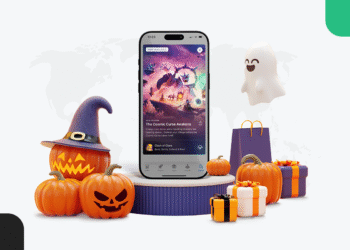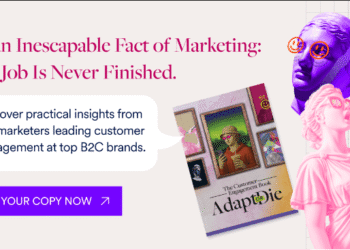Reading Time: 4 minutes
Marketers today are swimming in data, but that data often lives in disconnected dashboards and silos, creating what some call “data hell.” The real challenge isn’t collecting more information; it’s using that information to make confident, timely decisions that drive results. In a recent webinar, three contributors to MoEngage’s The Customer Engagement Book: Adapt or Die, Alec Haase of Hightouch, Natalie Miles of Grammarly, and Tiffany Fitzgerald of Movable Ink, shared their strategies for bridging the gap between insight and action.
They explore how to identify the data signals that matter most, align data with business goals, empower teams to act, and overcome the common blockers that delay execution. Below are the top five takeaways from their discussion.
Takeaway 1: Start with the Goal, Not the Data
With more data and more martech tools than ever before, it’s easy to get lost in the noise. The most successful teams don’t start by sifting through spreadsheets; they start with a clear objective and work backward. As discussed by the speakers, this approach is key to moving from information overload to purposeful insights. It’s about figuring out the outcome you want and then identifying the data you need to get there.
Alec’s experience at a neobank perfectly illustrates this. His team initially optimized their ad spend around form submissions, assuming this was a strong signal for new customers. But as he explained, “we ended up optimizing Facebook and all of our ad spend towards noisy events that we thought were valuable but at the end of the day weren’t.” The volume of form submissions was misleading. The real goal was to get new customers who actually deposited money. By shifting their focus to this ultimate goal and building predictive models, they were able to act on the right signal and drive a “major lift in qualified conversions.”
This story highlights a critical lesson: just because a metric can be measured doesn’t mean it’s the right one to act on.
Takeaway 2: Build a Foundational Data Process
Data silos and fragmented systems are a top challenge for marketers. Getting the data you need often requires a lengthy, multi-step process involving multiple teams. The solution is to build a single source of truth and empower your team with self-service capabilities. By doing so, you can ensure everyone is working with the same information, which streamlines workflows and accelerates decision-making.
Natalie’s strategy for Grammarly and Chime emphasizes this point. She advocates starting with the data’s intended use case, not the tech stack itself. No tool can solve fundamental data problems, so a centralized customer profile in a data warehouse should be considered the “source of truth.” By establishing this, companies can eliminate the problem of different teams having different answers based on which tool they’re looking at.
This foundational approach turns a disorganized mess into a system that supports consistent, reliable action.
Takeaway 3: Drive Change with Small, Strategic Wins
Getting organizational buy-in for a major data initiative can feel like an uphill battle. The secret is to start small, prove the value, and build on that success. By demonstrating a tangible, data-backed win, you can generate a company-wide buy-in that unlocks resources and aligns all the teams. This approach helps you overcome inertia and turn a pilot project into a top company priority.
Tiffany’s work with a music streaming client serves as a masterclass in this strategy. Instead of immediately launching a complex, fully automated campaign, her team “took something that was already in market and moved it into an app message and made it interactive.” They used existing creatives and a simple CSV file to test a new channel. This approach allowed them to quickly prove the value of an omnichannel strategy and show leadership the potential revenue impact. This initial success “gained the investment” they needed from the product and creative teams, transforming a small test into a full-scale launch.
This story proves that small, measurable wins are the most effective way to secure a commitment to a larger vision.
Takeaway 4: Avoid the Pitfalls of Chasing Perfection
The pursuit of a perfect, unified data set is a common pitfall that can bring projects to a grinding halt. As the speakers highlighted, the cost of waiting for perfect data is often an irreversible loss of time and learning. Sometimes, the data you have may be “good enough” to start.
Tiffany emphasized this point, stating: “I try to be data-driven and not data-led.” She believes that while data should inform decisions, a rigid reliance on flawless data can paralyze a team. This is a pitfall she saw frequently, where a company won’t try a new approach because “we tested it in 2021 and it didn’t work.” This mindset fails to account for changing customer behavior and market conditions. On the other hand, by embracing an “adapt or die” mentality, teams can move past outdated assumptions and re-engage with ideas that may now be viable.
The lesson is clear: progress outweighs perfection, and today’s data is more valuable than tomorrow’s ideal data set.
Takeaway 5: Look Beyond the Numbers for Qualitative Context
It’s not enough to simply find a correlation in your data. True insight comes from understanding the human context behind the numbers. As the speakers highlighted, acting on data without a deeper understanding of customer intent can lead you down the wrong path, wasting resources on campaigns that miss the mark. Alternatively, a data-driven approach requires curiosity and a willingness to investigate the “why” behind the “what.”
Alec shared one of his experiences: “We ended up optimizing around behavior without fully understanding the context behind it.” His team noticed that users who visited the pricing page twice were more likely to convert, so they began retargeting them. What they failed to see was that for many users, the multiple visits were a sign of “uncertainty or hesitation,” not high intent. This misinterpretation led to a failed campaign.
The takeaway here is crucial: Without qualitative context and a willingness to challenge your own assumptions, you can easily fall into the trap of acting on a correlation that doesn’t tell the whole story.
Ready to Turn Your Data into Decisions?
The journey from data to decisions is a continuous process of curiosity, experimentation, and adaptation. The key is not to have perfect data, but to move fast, start small, and act with conviction.
Want to hear more from these experts? Watch the full webinar on demand to learn more about their strategies, systems, and lessons from the marketing trenches.
The post Turning Customer Insights into Marketing Action: 5 Takeaways appeared first on MoEngage.


















![Last Click Attribution is Dead: Here’s How to Fix it [MozCon 2025 Speaker Series]](https://mgrowtech.com/wp-content/uploads/2025/05/MozCon-25-Speaker-Profile-Cards-Luke-Carthy-120x86.png)
